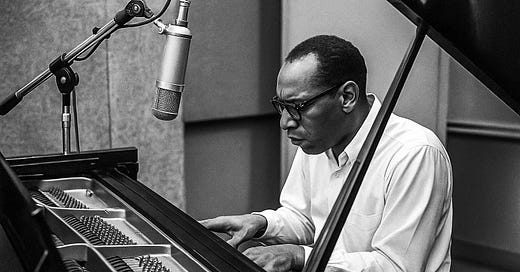There are openings in popular music that rupture the timeline—the kind you recognize before you even know the name. Bob Dylan’s “Like a Rolling Stone” has one of those. It barrels out of the speakers like a drunken parade stumbling into consciousness – drums tumble, Bloomfield’s guitar slices the frame, and then, there it is—the piano. Slippery, sly, both rooted and airborne. That’s Paul Griffin.
Much has been written about Al Kooper’s serendipitous arrival at the Hammond organ—his “mistake” now canonized as genius. But Kooper was reacting to something. Something older. Something worn and wooden, a bit out of tune, and aching with American soul. That “something” was Griffin’s piano. Not a grand piano. Not even a studio-perfect upright. It sounded like it came with the furniture—maybe even the house. It was Griffin’s charm, making the aged sing like gospel in the heat.
In those first ten seconds, Griffin speaks in grace notes and ghosts. He slips across the keys like Floyd Cramer moonwalking through a Harlem storefront church. It’s more than accompaniment—it’s invocation. Kooper may hold the note, but Griffin casts the spell.
Through the track, Griffin is everywhere and nowhere—buried, bouncing, tapping like a preacher’s foot under the pulpit. At times, he echoes the melody; at others, he betrays it. He moves between chopped gospel, rolling boogie, and bluesy flicks that sound like they wandered off a Jerry Lee Lewis session. He and Bloomfield share a Southern dialect—string bends and barroom hiccups that gave Dylan the swagger he needed to reinvent himself as a full-blown electric prophet.
But Paul Griffin wasn’t just a one-track wonder.
Born August 6, 1937, in Harlem, Griffin’s musical education began the only way it should—with gospel. Paradise Baptist Church gave him the fire, the feel, the foot stomp that never left his playing. He studied at New York’s High School of Music & Art, but it wasn’t long before the clubs and studios called him away. He cut his teeth with saxophone screamer King Curtis—church met chitlin circuit. It stuck.
By the early '60s, Griffin had become the session pianist of record. He didn’t play over you—he played through you. A gospel heart with a streetwise ear. That rare touch that could slip inside the cracks of a song and make the whole thing bloom. His fingerprints are all over the American pop tapestry, even if most folks never knew his name.
Want proof? Dig the records:
Bob Dylan – “Like a Rolling Stone”, Highway 61 Revisited
Bob Dylan – “Just Like Tom Thumb’s Blues,” “Queen Jane Approximately,” “Tombstone Blues” – that same 1965 session fire
Bob Dylan – Blonde on Blonde – Griffin returns in fragments, coloring Dylan’s descent into amphetamine surrealism
Don McLean – “American Pie” – That gospel-meets-boogie storm that sends the Chevy to the levee and back again? That’s Griffin.
Dionne Warwick – “Walk On By,” “Anyone Who Had a Heart” – Hal David and Burt Bacharach may have framed it, but Griffin gave the melodies a place to cry.
B.J. Thomas – “Raindrops Keep Fallin’ on My Head” – a piano that tiptoes through sun showers.
Van Morrison – Moondance sessions – uncredited moments of moonlit swing and jazz-flecked finesse.
Steely Dan – “Peg”, Aja – When the Dan wanted soul that didn’t show up on sheet music, they called Griffin.
Steely Dan – “The Fez” – Co-writing credit, a unicorn in the Steely Dan canon, proof Griffin wasn’t just playing along—he was writing part of the script.
The Shirelles – “Will You Love Me Tomorrow” – a question for the ages, asked from the keys of innocence.
The Isley Brothers – “Twist and Shout” – raw R&B energy, punched and punctuated by Griffin’s organ fire.
Chuck Jackson – “Any Day Now” – soul swagger and quiet heartbreak, wrapped in Griffin’s ivory dust.
The Drifters – “Up On the Roof” – the sound of elevation, escape, and piano as solace.
Laura Nyro – Eli and the Thirteenth Confession sessions – avant-soul, and Griffin was her co-conspirator.
The Warriors (1979) – Arrangements that echoed cityscape and cinema—Griffin as orchestrator of tension.
Four Friends (1981) – film music with soul in the strings and city in the bones.
And the list goes deeper, like the liner notes of a lost era. Hundreds of cuts. Thousands of bars. Notes that never got the ink they deserved.
Paul Griffin died on June 14, 2000, in the Bronx. Heart attack. Diabetes. He was waiting for a liver transplant that never came. But he left behind a trail of music that refuses to die.
Griffin never chased fame. Never fronted a band or headlined a tour. He was a ghost in the machine. A sideman with the soul of a frontman. A man who could make a piano feel like a human voice.
Next time “Like a Rolling Stone” comes on, forget the organ swell and the sneer. Listen closely. The first ten seconds. That’s Griffin. That’s the soul of the song.





